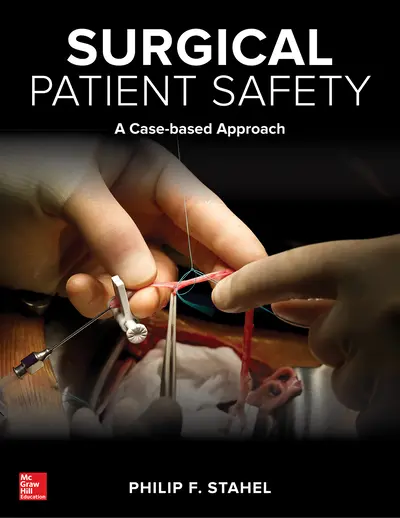My Account Details

ISBN10: 0071842632 | ISBN13: 9780071842631

Step 1 . Download Adobe Digital Editions to your PC or Mac desktop/laptop.
Step 2. Register and authorize your Adobe ID (optional). To access your eBook on multiple devices, first create an Adobe ID at account.adobe.com. Then, open Adobe Digital Editions, go to the Help menu, and select "Authorize Computer" to link your Adobe ID.
Step 3. Open Your eBook. Use Adobe Digital Editions to open the file. If the eBook doesn’t open, contact customer service for assistance.
Publisher's Note: Products purchased from Third Party sellers are not guaranteed by the publisher for quality, authenticity, or access to any online entitlements included with the product. Put patient safety at the center of your surgical protocol—with this essential case-based guide Despite many advances in the practice of surgery, surgical complications continue to cause significant patient morbidity and mortality. Now more than ever, it is the responsibility of every surgeon to take the lead in understanding and mitigating complications and adverse events. Surgical Patient Safety: A Case-based Approach is your blueprint for putting this goal within reach. This timely resource gives you all the insights needed to effectively manage patient safety, covering everything from sharpening communication skills to establishing shared decision-making with patients and their families. Supplementing this important content are numerous case-based examples and exercises, supported by color illustrations, tables, figures, radiographs, and algorithms. Taken as a whole, this new textbook represents a one-stop, hands-on patient safety primer that no other sourcebook can match. Surgical Patient Safety represents a vital call to action—one designed to inspire a physician-driven initiative fostering a global culture of patient safety. Features • The latest practical patient safety tools for surgeons in training, including surgical safety checklists, intraoperative “rescue” strategies, and the global implementation of new regulatory compliance guidelines • Case-based scenarios examining technical challenges and bail-out options in the operating room • Bulleted “pearls and pitfalls” that take you through the decision-making process for diagnostic work up and revision of specific complications • Insights from renowned experts that explain how to handle malpractice lawsuits; navigate the modern dangers of electronic health records; apply the pragmatic “IKEA approach” for patient advocacy; and much more • A must-read for all practicing surgeons, independent of the surgical subspecialty
I. General Aspects
Chapter 1: Definitions
Chapter 2: Non-Technical Aspects of Safe Surgical Performance
Chapter 3: Cognitive Errors
Chapter 4: Professionalism in Surgery
Chapter 5: The Surgical M&M Conference
Chapter 6: Evidence-based Medicine and Patient Safety
Chapter 7: Electronic Medical Records and Patient Safety
II. Practical Aspects
Chapter 8: Tips and Tricks of Effective Communication
Chapter 9: Tips and Tricks for Informed Consent and Shared Decision-Making
Chapter 10: Surgical Safety Checklists – Pitfalls and Pearls
Chapter 11: Strategies for Preventing Surgical Complications
Chapter 12: Intraoperative ‘Rescue’ Strategies
Chapter 13: How to Disclose Complications
Chapter 14: How to Become a Safe Surgeon
Chapter 15: How to Become an Empathetic Surgeon
Chapter 16: How to Become a Transparent Surgeon
III. Technical Errors
Chapter 17: Technical Errors in General Surgery
Chapter 18: Technical Errors in Abdominal Surgery
Chapter 19: Technical Errors in Thoracic Surgery
Chapter 20: Technical Errors in Vascular Surgery
Chapter 21: Technical Errors in Urological Surgery
Chapter 22: Technical Errors in Gynecological Surgery
Chapter 23: Technical Errors in Transplantation Surgery
Chapter 24: Technical Errors in Neurosurgery
Chapter 25: Technical Errors in Orthopedic Surgery
Chapter 26: Technical Errors in Spine Surgery
Chapter 27: Technical Errors in Emergency Surgery
IV. Case Examples of non-technical complications
Chapter 29: Case Example #1: Breakdown in Communication
Chapter 30: Case Example #2: Error in Judgment
Chapter 31: Case Example #3: The Preventable In-Hospital Death
V. Conclusion and Future Perspectives
Chapter 32: The Surgeon-Driven Initiative for Surgical Patient Safety
Need support? We're here to help - Get real-world support and resources every step of the way.